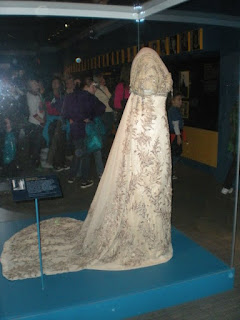Let's get one thing straight: I am not a fashionista. Sure, I have my own personal style, but it usually involves a pair of jeans. Nothing fancy.
But ever since coming to Spain, my style has changed. Not a lot, but enough to be noticeable. Our Study Abroad program suggested it: "Dress nicer," they said. "You'll blend in better. No sneakers, no sweatpants, no t-shirts."
(Side note: I don't blend in. My backpack is a dead giveaway, but I like it too much to sacrifice it for some European swag. Besides, everyone knows I'm not a local as soon as I open my mouth, so why bother?)
 |
| Gown of First Lady Helen Taft. So early 1900s. |
For the most part, I've adhered to the advice. More skirts, better shoes. The other day I even wore a pair of patterned harem pants. (Bold, I know. But they're so comfortable!) Anyway, as I've been toying with my own sense of style, I got to thinking about fashion in writing. Our characters have to be dressed, don't they? (Well, not always…)
Writing about clothes is fun, at least for me. However, there is a line. I firmly believe that descriptions of clothes should be used for a greater purpose, not only to tell the reader what a character is wearing. Luckily, most writers do this unconsciously: the stereotypical popular crowd in a YA contemporary is almost always in miniskirts, while the academically inclined protagonist opts for Target jeans. What does that say about them?
(Side note: I strongly dislike books that heavily rely on the stereotypical popular crowd as a plot device because I don't find it believable. Mean Girls works because it's satire.)
| Moroccan gowns. Present day. |
A girl who only wears baggy clothes might be self-conscious about her weight. A boy in Nantucket red pants could easily be a frat brother.
The Hunger Games is a great example of fashion for a purpose. There isn't much description of Katniss's everyday clothes, or even the clothes she wears while in the arena, but we all remember her clothes that make a statement and give a sense of her character: the coal costumes that catch fire, the dress with the flames, the Mockingjay wedding gown.
The Hunger Games is a great example of fashion for a purpose. There isn't much description of Katniss's everyday clothes, or even the clothes she wears while in the arena, but we all remember her clothes that make a statement and give a sense of her character: the coal costumes that catch fire, the dress with the flames, the Mockingjay wedding gown.
Ok, so not too difficult. What's a little trickier is avoiding over-description.
I know people who go online shopping for their characters. Great! It helps them get a better mental picture of their characters, and it sounds like a lot of fun. But they run the danger of wanting to describe every single detail, down to the very thread-count. That's a big no-no, because frankly, the reader doesn't care that much. If you must talk about fashion, mention it briefly, and move on.
However, there is a time to linger, and that's when your PoV character is doing commentary. (Remember: even if you write in third person, you still have a PoV character). If a character is surprised by an outfit, perhaps. Or if she's jealous. Or if the clothes are new, or offensive. If a proper nineteenth-century Englishwoman travels to a country where harem pants are big, she might be a little taken aback, and therefore she'll linger on them.
But don't linger too much. Otherwise the reader will think, "We get the point! Move on."
 |
| Colonial style, circa 1780. |
Sometimes it is difficult to move on. I'm guilty. I love to write about my characters' outfits, especially since most of my work isn't contemporary, which means cool historical clothes like the ones in the photos. I also tend to set my work all over the world, so I have to be conscious of international and historical fashion. When I go to museums, I take pictures of the clothing, especially, so I can look at them for later reference. Also, the Internet is a wonderful wonderful thing. Movies can also be very helpful.
Your thoughts on fashion in writing?
You should put this on Dorm Room! I really don't tend to describe clothes at all, for some reason -- except, strangely, hats. Definitely an inspiration to start thinking about that a little more.
ReplyDelete